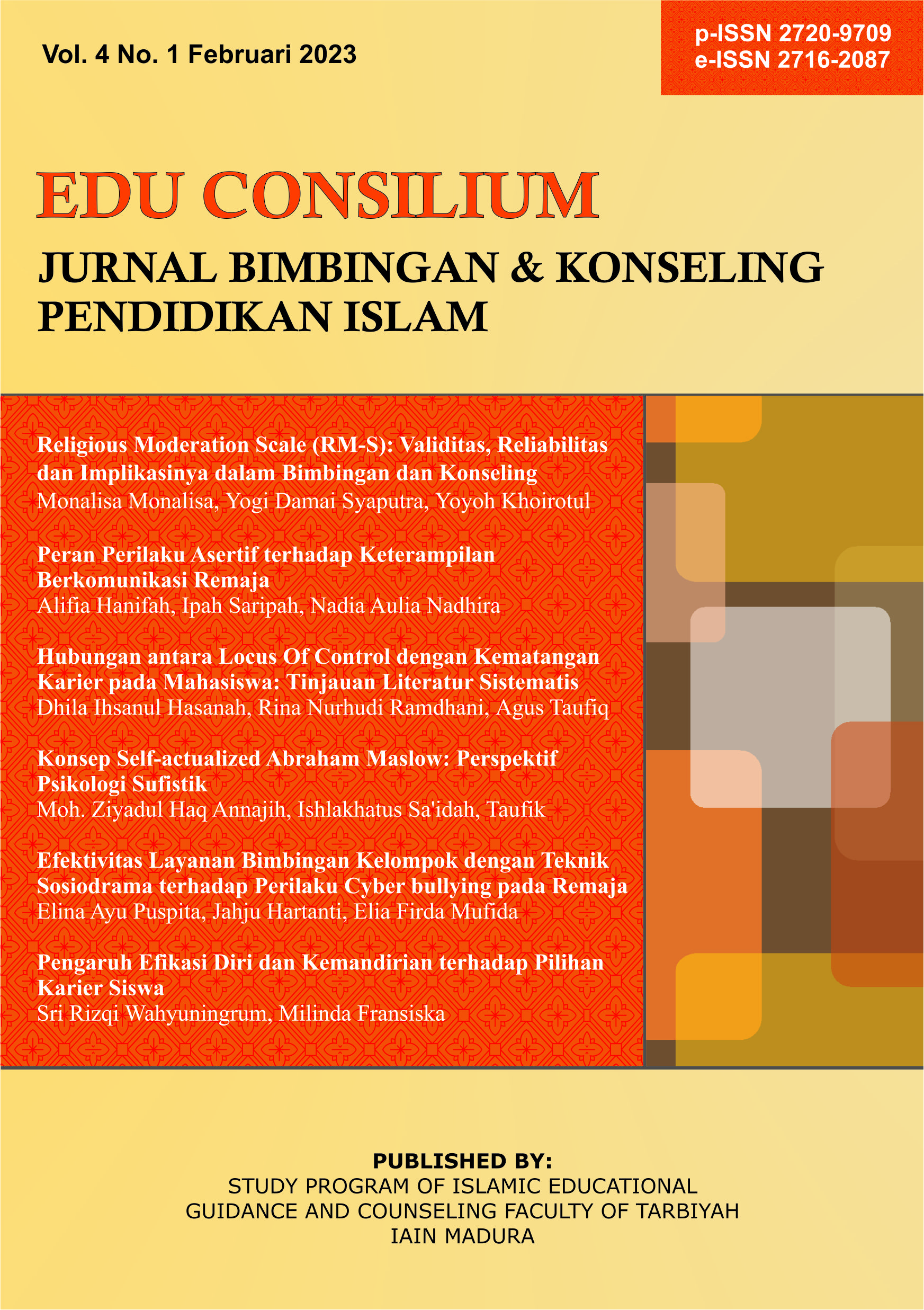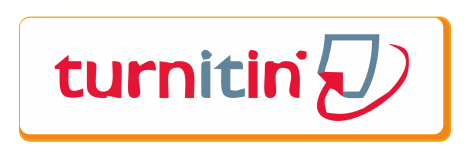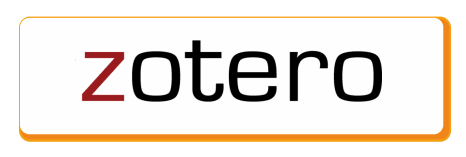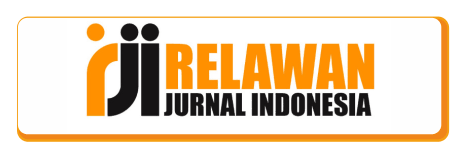Pengaruh Efikasi Diri dan Kemandirian terhadap Pilihan Karier Siswa
 Abstract views: 783
,
Abstract views: 783
,
 PDF downloads: 756
PDF downloads: 756
Abstract
One of the factors that needed to have the right career choice is self-efficacy. Self-efficacy is an individual’s bekief in his ability that influences the way individual reacts to certain situations ang conditions. The purpose of this study is to determine the relationship between self-efficacy and independence in student’s career choices and to find how big relationship between self-efficacy and independence in student’s career choice. The study uses quantitative methods. The data collection technique used is a questionnaire by distributing questionnaires to students. The population in this study was 345 while the sample was 70 students. The data analysis technique used is descriptive statistics, and for data analysis using simple linear regression, t test, and coefficient determination (R2). The results of the partial test (t test) for the self-efficacy variable obtained a significance value of 0,015 0,05 and a t-cont value of t-table where the t-count is 2,484 while the t-table is 1,977, meaning that there is significant relationship between self-efficacy and independence in career choice. From the results of the normality test, it knows that self-efficacy is normal with a significant value of 0,45452 0,05, which means that there is a relationship between self-efficacy and independence for the student’s career choice.
Downloads
References
Aisa, A., Hasanah, I., Hasanah, U., & Wahyuningrum, S. R. (2021). Self-healing untuk Mengurangi Stres Akademik Mahasiswa Saat Kuliah Daring. Pamomong, 2(2), 136–153. https://doi.org/10.18326/pamomong.v2i2.136-153
Alwisol. (2011). Psikologi Kepribadian. UMM Press.
Apriansyah, A., & dkk. (2018). Hubungan Antara Efikasi Diri Dengan Kemampuan Pengambilan Keputusan Karier Siswa Man 2 Kota Bengkulu. Onsila: Jurnal Ilmiah Bimbingan Dan Konseling, 1(3).
Dolet, D. U. (2019). Metode Penelitian Kuantitatif. Universitas Katolik Indonesia Jaya.
Firmanu, A. J., & dkk. (2020). Pengaruh Efikasi Diri Terhadap Kecemasan Presentasi Siswa Kelas XI di SMA Negeri 1 Wuryantoro. Konseling Edukasi : Journal Of Guidance and Counseling, 4(1).
Kurniawati, D. (2015). Hubungan Antara Efikasi Diri Dengan Kemandirian Belajar Siswa Kelas V Sd Negeri Se-Kecamatan Srandakan Bantul Yogyakarta Tahun Ajaran 2015/2016. Media Abadi.
Mufrihah, A., Hasanah, I., Aisa, A., & Wahyuningrum, S. R. (2021). Pengenalan Potensi dan Arah Peminatan Remaja. Jurnal Pengabdian Pada Masyarakat, 6(4), Article 4. https://doi.org/10.30653/002.202164.872
Nasution, T. (2018). Membangun Kemandirian Siswa Melalui Pendidikan Karakter. Ijtimaiyah, 2(1).
Novi, I. S. (2018). Layanan Informasi Karier Sebagai Prediktor Kemandirian Pemilihan Karier. Ciencias: Jurnal Penelitian Dan Pengembangan Pendidikan, 1(1).
Pintrich, Paul R and, D. G., & Elisabeth, V. (1990). Motivational and Self Regulated Learning Components of Classroom Academic Performance. Journal of Educational Psychology, 82(1).
Rahmi, F. (2019). Efikasi Diri Dalam Membuat Keputusan Karier Pada Mahasiswa. InSight, 21(1).
Ulfah, A. K., Razali, R., Rahman, H., Ghofur, A., Bukhory, U., Wahyuningrum, S. R., Yusup, M., Inderawati, R., & Muqoddam, F. (2022). RAGAM ANALISIS DATA PENELITIAN (Sastra, Riset dan Pengembangan). IAIN Madura Press.
Wahyuningrum, S. R. (2020). Statistika Pendidikan (Konsep Data dan Peluang). Jakad Media Publishing.
Wahyuningrum, S. R., & Muhlis, A. (2020). Statistika Pendidikan Edisi Kedua (dengan Statistika Al-Qur’an). Jakad Media Publishing.
Wahyuningrum, S. R., Putri, A. P., & Jamaluddin, M. (2021). Pre-Experimental Design Bimbingan Kelompok dengan Teknik Assertive Training dalam Peningkatan Keterampilan Komunikasi Siswa di SMK Kesehatan Nusantara. NUANSA: Jurnal Penelitian Ilmu Sosial Dan Keagamaan Islam, 18(1), Article 1. https://doi.org/10.19105/nuansa.v18i1.4242
Wahyuningrum, S. R., & Riskiyah, E. H. (2021). Implementasi Pemanfaatan Media Sosial dalam Meningkatkan Penjualan Kerupuk Puli Pada Masa Pandemi Covid-19 di Desa Larangan Tokol, Pamekasan. Jurnal Pengabdian Masyarakat: Darma Bakti Teuku Umar, 3(2).
Winkel, W., & Hartuti, S. (2013). Bimbingan dan Konseling Di Institusi Pendidikan. Media Abadi.
The journal operates an Open Access policy under a Creative Commons Non-Commercial 4.0 International license. Authors who publish with this journal agree to the following terms:
- Authors retain copyright and grant the journal right of first publication with the work simultaneously licensed under a
 Commons Attribution-NonCommercial 4.0 International License
Commons Attribution-NonCommercial 4.0 International Licensethat allows others to share — copy and redistribute the material in any medium or format, and adapt — remix, transform, and build upon the material.
- Authors are able to enter into separate, additional contractual arrangements for the non-exclusive distribution of the journal's published version of the work (e.g., post it to an institutional repository or publish it in a book), with an acknowledgement of its initial publication in this journal.
- Authors are permitted and encouraged to post their work online (e.g., in institutional repositories or on their website) prior to and during the submission process, as it can lead to productive exchanges, as well as earlier and greater citation of published work (see The Effect of Open Access).




















